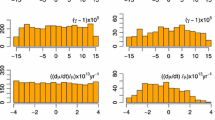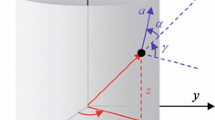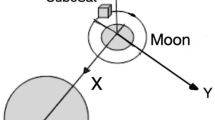Abstract
In this paper, the design of science orbits for the observation of a celestial body has been carried out using polynomial equations. The effects related to the main zonal harmonics of the celestial body and the perturbation deriving from the presence of a third celestial body have been taken into account. The third body describes a circular and equatorial orbit with respect to the primary body and, for its disturbing potential, an expansion in Legendre polynomials up to the second order has been considered. These polynomial equations allow the determination of science orbits around Jupiter’s satellite Europa, where the third body gravitational attraction represents one of the main forces influencing the motion of an orbiting probe. Thus, the retrieved relationships have been applied to this moon and periodic sun-synchronous and multi-sun-synchronous orbits have been determined. Finally, numerical simulations have been carried out to validate the analytical results.






Similar content being viewed by others
References
Alvarellos, J.L.: Perturbations on a stationary satellite by the longitude-dependent terms in Mars’ gravitational field. J. Astronaut. Sci. 57(4), 701–715 (2010)
Anderson, J.D., Schubert, G., Jacobson, R.A., Lau, E.L., Moore, W.B., Sjogren, W.L.: Europa’s differentiated internal structure: inferences from four Galileo encounters. Science 281(5385), 2019–2022 (1998)
Broucke, R.A.: Long-term third-body effects via double averaging. J. Guid. Control Dyn. 26(1), 27–32 (2003)
Circi, C., Ortore, E., Bunkheila, F., Ulivieri, C.: Elliptical multi-sun-synchronous orbits for Mars exploration. Celest. Mech. Dyn. Astron. 114(3), 215–227 (2012)
Coffey, S.L., Deprit, A., Miller, B.L.: The critical inclination in artificial satellite theory. Celest. Mech. Dyn. Astron. 39(4), 365–406 (1986)
Coffey, S.L., Deprit, A., Deprit, E.: Frozen orbits for satellites close to an Earth-like planet. Celest. Mech. Dyn. Astron. 59(1), 37–72 (1994)
Domingos, R.C., Vilhena de Moraes, R., Prado, A.F.B.A.: Third-body perturbation in the case of elliptic orbits for the disturbing body. Math. Probl. Eng. Article ID 763654, p. 14 (2008)
Kozai, Y.: The motion of a close Earth satellite. Astron. J. 64(1274), 367–377 (1959)
Lara, M.: Repeat ground track orbits of the Earth tesseral problem as bifurcations of the equatorial family of periodic orbits. Celest. Mech. Dyn. Astron. 86(2), 143–162 (2003)
Lara, M., San Juan, J.F.: Dynamic behavior of an orbiter around Europa. J. Guid. Control Dyn. 28(2), 291–297 (2005)
Lara, M., San Juan, J.F., Ferrer, S.: Secular motion around triaxial, synchronously orbiting, planetary satellites: application to Europa. Chaos: an interdisciplinary. J. Nonlinear Sci. 15(4), 043101-1–043101-11 (2005)
Lara, M., Russell, R.P.: Computation of a science orbit about Europa. J. Guid. Control Dyn. 30(1), 259–263 (2007)
Lara, M.: Simplified equations for computing science orbits around planetary satellites. J. Guid. Control Dyn. 31(1), 172–181 (2008)
Liu, X., Baoyin, H., Ma, X.: Five special types of orbits around Mars. J. Guid. Control Dyn. 33(4), 1294–1301 (2010)
Liu, X., Baoyin, H., Ma, X.: Analytical investigations of quasi-circular frozen orbits in the Martian gravity field. Celest. Mech. Dyn. Astron. 109(3), 303–320 (2011)
Liu, X., Baoyin, H., Ma, X.: Periodic orbits around areostationary points in the Martian gravity field. Res. Astron. Astrophys. 12(5), 551–562 (2012)
Merson, R.H.: The motion of a satellite in an axi-symmetric gravitational field. Geophys. J. Int. 4(Supplement 1), pp. 17–52 (1961)
Ortore, E., Circi, C., Bunkheila, F., Ulivieri, C.: Earth and Mars observation using periodic orbits. Adv. Space Res. 49(1), 185–195 (2012)
Ortore, E., Circi, C., Bunkheila, F., Ulivieri, C.: Retrieval of aerosol properties by using low earth orbit. Aerosp. Sci. Technol. 30(1), 333–338 (2013)
Ortore, E., Circi, C., Ulivieri, C., Cinelli, M.: Multi-sunsynchronous orbits in the solar system. Earth Moon Planets 111(3–4), 157–172 (2014)
Paskowitz, M.E., Scheeres, D.J.: Design of science orbits about planetary satellites: application to Europa. J. Guid. Control Dyn. 29(5), 1147–1158 (2006)
Prado, A.F.B.A.: Third-body perturbation in orbits around natural satellites. J. Guid. Control Dyn. 26(1), 33–40 (2003)
Russell, R.P., Lara, M.: Long-lifetime lunar repeat ground track orbits. J. Guid. Control Dyn. 30(4), 982–993 (2007)
Russell, R.P., Lara, M.: On the design of an Enceladus science orbit. Acta Astronaut. 65(1–2), 27–39 (2009)
Scheeres, D.J., Guman, M.D., Villac, B.F.: Stability analysis of planetary satellite orbiters: application to the Europa orbiter. J. Guid. Control Dyn. 24(4), 778–787 (2001)
Silva, J.J., Pilar, R.: Optimal longitudes determination for the station keeping of areostationary satellites. Planet. Space Sci. 87, 14–18 (2013)
Author information
Authors and Affiliations
Corresponding author
Rights and permissions
About this article
Cite this article
Cinelli, M., Circi, C. & Ortore, E. Polynomial equations for science orbits around Europa. Celest Mech Dyn Astr 122, 199–212 (2015). https://doi.org/10.1007/s10569-015-9616-5
Received:
Revised:
Accepted:
Published:
Issue Date:
DOI: https://doi.org/10.1007/s10569-015-9616-5




